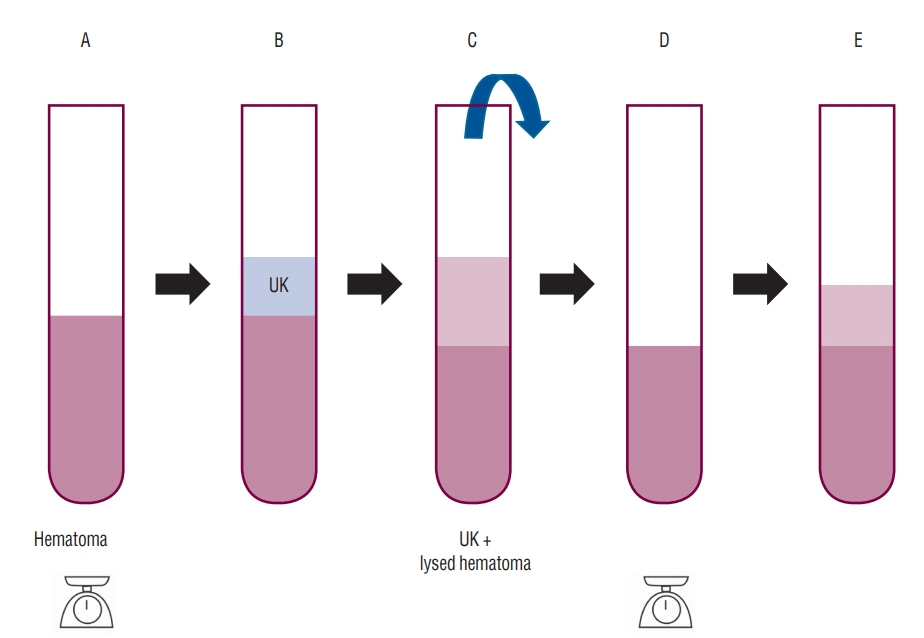J Korean Neurosurg Soc.
2020 May;63(3):380-385. 10.3340/jkns.2018.0224.
In-Vitro Study of Urokinase Thrombolysis Following Stereotactic Aspiration of Intracerebral Hematoma
- Affiliations
-
- 1Department of Neurosurgery, School of Medicine, Kyungpook National University, Daegu, Korea
- 2Department of Clinical Trial Center, Kyungpook National University Hospital, Daegu, Korea
- KMID: 2501726
- DOI: http://doi.org/10.3340/jkns.2018.0224
Abstract
Objective
: A consensus regarding the ideal regimen for urokinase (UK) thrombolysis subsequent to stereotactic spontaneous intracerebral hemorrhage aspiration has yet to be established. The purpose of this study is to evaluate the efficacy of UK thrombolysis relative to when the regimen is changed.
Methods
: Venous blood from 30 heathy volunteers was obtained for this in-vitro study. Various concentrations of UK solution were added to microcentrifuge tubes containing the clotted blood. The efficacy of UK thrombolysis was identified by checking the weight of lysed hematoma following various time intervals with different concentrations of UK solution. Group one, the “3×4” group involved four administrations every 3 hours over 12 hours, and group two, the “6×2” group involved two administrations every 6 hours over 12 hours.
Results
: More hematoma was lysed in the 3×4 group than the 6×2 group across all concentration levels (however, the differences were only significant between groups at the 500 and 1000 IU concentration levels, p<0.05). There were no significant differences of lysed hematoma among the various UK solution concentrations within groups.
Conclusion
: This study suggests that frequent administrations of UK thrombolysis may result in a greater degree of lysed hematoma in comparison to a higher concentration of UK.
Figure
Reference
-
References
1. Aydin IH, Takçi E, Kadioglu HH, Kayaoglu CR, Tüzün Y. The effect of urokinase on experimental intracerebral haematomas. Zentralbl Neurochir. 55:29–34. 1994.2. Chang YH, Hwang SK. Frameless stereotactic aspiration for spontaneous intracerebral hemorrhage and subsequent fibrinolysis using urokinase. J Cerebrovasc Endovasc Neurosurg. 16:5–10. 2014.
Article3. Chen X, Chen W, Ma A, Wu X, Zheng J, Yu X, et al. Frameless stereotactic aspiration and subsequent fibrinolytic therapy for the treatment of spontaneous intracerebral haemorrhage. Br J Neurosurg. 25:369–375. 2011.
Article4. Gaberel T, Macrez R, Gauberti M, Montagne A, Hebert M, Petersen KU, et al. Immunotherapy blocking the tissue plasminogen activatordependent activation of N-methyl-D-aspartate glutamate receptors improves hemorrhagic stroke outcome. Neuropharmacology. 67:267–271. 2013.
Article5. Gaberel T, Montagne A, Lesept F, Gauberti M, Lemarchand E, Orset C, et al. Urokinase versus Alteplase for intraventricular hemorrhage fibrinolysis. Neuropharmacology. 85:158–165. 2014.
Article6. Keric N, Maier GS, Samadani U, Kallenberg K, Dechent P, Brueck W, et al. Tissue plasminogen activator induced delayed edema in experimental porcine intracranial hemorrhage: reduction with plasminogen activator inhibitor-1 administration. Transl Stroke Res. 3:88–93. 2012.
Article7. Lian L, Xu F, Hu Q, Liang Q, Zhu W, Kang H, et al. No exacerbation of perihematomal edema with intraclot urokinase in patients with spontaneous intracerebral hemorrhage. Acta Neurochir (Wien). 156:1735–1744. 2014.
Article8. Lippitz BE, Mayfrank L, Spetzger U, Warnke JP, Bertalanffy H, Gilsbach JM. Lysis of basal ganglia haematoma with recombinant tissue plasminogen activator (rtPA) after stereotactic aspiration: initial results. Acta Neurochir (Wien). 127:157–160. 1994.
Article9. Meunier JM, Wenker E, Lindsell CJ, Shaw GJ. Individual lytic efficacy of recombinant tissue plasminogen activator in an in vitro human clot model: rate of “nonresponse”. Acad Emerg Med. 20:449–455. 2013.
Article10. Montes JM, Wong JH, Fayad PB, Awad IA. Stereotactic computed tomographic-guided aspiration and thrombolysis of intracerebral hematoma : protocol and preliminary experience. Stroke. 31:834–840. 2000.
Article11. Narayan RK, Narayan TM, Katz DA, Kornblith PL, Murano G. Lysis of intracranial hematomas with urokinase in a rabbit model. J Neurosurg. 62:580–586. 1985.
Article12. Naval NS, Nyquist P, Carhuapoma JR. ICH aspiration and thrombolysis. J Neurol Sci. 261:80–83. 2007.
Article13. Niizuma H, Otsuki T, Johkura H, Nakazato N, Suzuki J. CT-guided stereotactic aspiration of intracerebral hematoma--result of a hematomalysis method using urokinase. Appl Neurophysiol. 48:427–430. 1985.
Article14. Ouriel K, Welch EL, Shortell CK, Geary K, Fiore WM, Cimino C. Comparison of streptokinase, urokinase, and recombinant tissue plasminogen activator in an in vitro model of venous thrombolysis. J Vasc Surg. 22:593–597. 1995.
Article15. Prasad S, Kashyap RS, Deopujari JY, Purohit HJ, Taori GM, Daginawala HF. Development of an in vitro model to study clot lysis activity of thrombolytic drugs. Thromb J. 4:14. 2006.
Article16. Rohde V, Rohde I, Thiex R, Ince A, Jung A, Dückers G, et al. Fibrinolysis therapy achieved with tissue plasminogen activator and aspiration of the liquefied clot after experimental intracerebral hemorrhage: rapid reduction in hematoma volume but intensification of delayed edema formation. J Neurosurg. 97:954–962. 2002.
Article17. Samadani U, Rohde V. A review of stereotaxy and lysis for intracranial hemorrhage. Neurosurg Rev. 32:15–21. discussion 21-22. 2009.
Article18. Tan Q, Chen Q, Niu Y, Feng Z, Li L, Tao Y, et al. Urokinase, a promising candidate for fibrinolytic therapy for intracerebral hemorrhage. J Neurosurg. 126:548–557. 2017.
Article19. Teernstra OP, Evers SM, Lodder J, Leffers P, Franke CL, Blaauw G. Stereotactic treatment of intracerebral hematoma by means of a plasminogen activator: a multicenter randomized controlled trial (SICHPA). Stroke. 34:968–974. 2003.
Article20. Wang GQ, Li SQ, Huang YH, Zhang WW, Ruan WW, Qin JZ, et al. Can minimally invasive puncture and drainage for hypertensive spontaneous Basal Ganglia intracerebral hemorrhage improve patient outcome: a prospective non-randomized comparative study. Mil Med Res. 1:10. 2014.
Article21. Zeumer H, Freitag HJ, Zanella F, Thie A, Arning C. Local intra-arterial fibrinolytic therapy in patients with stroke: urokinase versus recombinant tissue plasminogen activator (r-TPA). Neuroradiology. 35:159–162. 1993.
Article
- Full Text Links
- Actions
-
Cited
- CITED
-
- Close
- Share
- Similar articles
-
- Clinical Analysis of Stereotactic aspiration in the Management of Spontaneous Intracerebral Hemorrhage
- Streotactic Evacuation and Urokinase Irrigation in the Management of Spontaneous Intracerebral Hemorrhage
- Stereotactic Removal of Spontaneous Intracerebral Hematoma Using Hematome and Urokinase
- Navigation-assisted Aspiration and Thrombolysis of Deep Intracerebral Hemorrhage
- Clinical analysis of Stereotactic Aspiration in Basal Ganglia Hematoma


